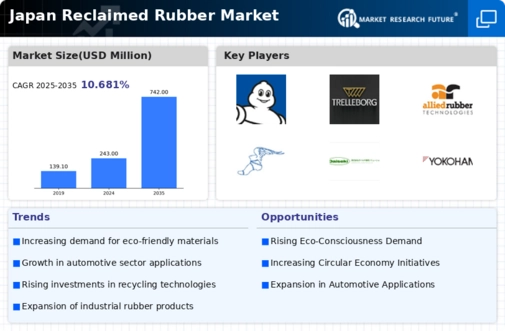The Japan Reclaimed Rubber Market presents a unique landscape characterized by its focus on sustainability and innovation within the rubber recycling industry. As environmental concerns grow, the demand for reclaimed rubber is increasing due to its potential to reduce waste and lower production costs. Companies are vying for market share by investing in research and development, enhancing quality assurance, and expanding their operational capabilities.
This competitive arena is marked by the emergence of domestic and international firms, each striving to leverage technological advancements and eco-friendly practices to meet the evolving preferences of consumers and industries alike. Understanding the strengths and positioning of key players in this market is crucial for stakeholders looking to navigate the complexities and opportunities prevalent in Japan's reclaimed rubber industry.
Michelin, a well-known name in the global tire industry, has established a significant presence in the Japan Reclaimed Rubber Market. The company's strong reputation for quality and innovation serves as a key advantage in its efforts to cater to the growing demand for sustainable materials. Michelin's commitment to environmental stewardship is reflected in its initiatives aimed at recycling rubber waste and developing high-performance reclaimed rubber products. This dedication not only bolsters its product offerings but also enhances its brand loyalty among consumers who prioritize sustainable practices.
Michelin leverages its extensive distribution network and established relationships with local partners to strengthen its market position, ensuring that it remains competitive in providing reclaimed rubber solutions tailored to the Japanese market's specific needs.
Trelleborg has also carved out a niche within the Japan Reclaimed Rubber Market, focusing primarily on delivering innovative solutions and sustainable practices in rubber recycling. The company offers a range of key products and services that cater specifically to industrial applications, emphasizing the importance of reclaimed rubber in reducing overall production costs while ensuring high-quality performance. Trelleborg's strengths lie in its advanced technology and expertise in manufacturing processes, allowing for the development of reclaimed rubber products that meet stringent performance standards.
The company is also recognized for its strategic mergers and acquisitions that enhance its capabilities and product offerings in Japan. By adopting a proactive approach to market expansion and maintaining a commitment to technological advancements, Trelleborg effectively solidifies its role as a competitive player in the reclaimed rubber sector within Japan, responding to both local and global market trends.





















Leave a Comment